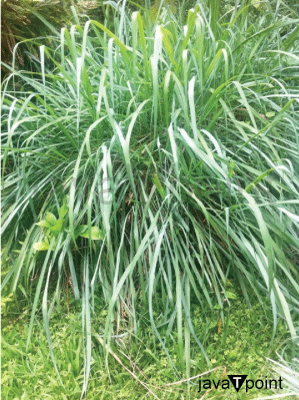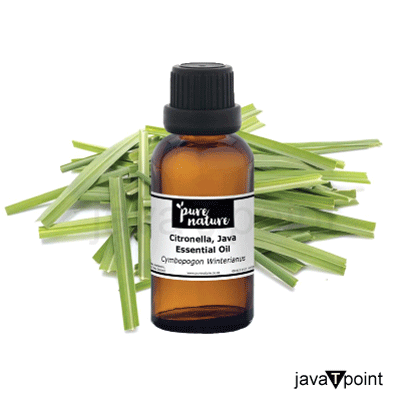Citronella JavaWhat is Citronella Java?Often referred to as "Java Citronella", Cymbopogon winterianus is a perennial rhizome plant that is native to Sri Lanka and Indonesia. Citronella has fibrous roots. It has glossy, smooth leaves that are glabrous at the nodes and grows over 2 m tall. It is a member of the Poaceae (grass) family. This plant is farmed in the states of Uttar Pradesh, Assam, Gujarat, Jammu & Kashmir, Karnataka, Maharashtra, Tamil Nadu, and West Bengal. 
When the stems of this fragrant grass (citronella) are distilled, essential oils are produced. All around the world, this is a major source for the industries of soap, flavoring, fragrance, and cosmetics. Oil of citronella is one of the essential oils that India produces in large quantities. Suitable ClimateTropical and sub-tropical climates are ideal for citronella. For healthy growth, it needs lots of hydration and sunlight. The development of the plant, yield, and oil quality appear to be positively influenced by a decent rainfall of around 2000-2500 mm evenly distributed throughout the year and high atmospheric humidity. The plant has been demonstrated to be able to grow in a variety of soil types, however sandy loam soil with a high amount of organic matter is the most suitable. Plants have a difficult time growing in sand and soils with a lot of clay. This plant has been seen to flourish when the pH is between 5.8 and 6.0. Agricultural SeasonDespite the fact that Java citronella plantations can begin at any time of the year, monsoon season is the ideal period. By tilling and discing, the ground should be ready for fine-tilth. The field should be sufficiently wet while planting takes place. Technique for Planting Citronella Java1. Land Preparation By deeply plowing, pulverizing the ground with crisscross harrowing, and dividing the field into 6 m-long side beds with irrigation canals, the soil is brought to a fine tilth. When doing final tillage, it is also advantageous to put in compost that has been well mixed into the soil. If you want to completely remove the possibility of termite infestation in standing crops, you may additionally apply 20-25 kg of BHC powder after you finish finalizing the ground preparation. 2. Planting These species can only be reproduced vegetatively because anomalies in meiosis prevent viable seeds from developing. To do this, one-year-old or even older clumps are dug up and divided into slips, each of which has two to three tillers. Before planting the slips, the fibrous roots and leaves need to be removed. One-year-old clumps typically produce 50 slips, according to observations. In order to ensure better establishment, even without watering, these slips are planted at the beginning of the monsoon. For planting, it has been discovered that the months of July and August and February and March are suitable. The slips are planted 8 to 12 cm deep in the ground. 3. Spacing The slips need to be planted 60 by 60 cm apart. However, a spacing of 90 cm × 90 cm may be used in regions where the soil is exceptionally fertile, and the climatic circumstances favor sumptuous development. 4. Irrigation For healthy development and a decent output of leaves, java citronella needs enough moisture. Supplemental irrigation is not required in regions with high humidity levels and annual rainfall of 200 to 250 cm that is evenly spread throughout the year. However, during the first month of planting and then once every five days after that, irrigation is supplied throughout the dry months. 5. Fertilisation and Manuring Generally speaking, java citronella needs a lot of nitrogen to develop well. About 80-120 kg N/ha per year is advised under the agroclimatic conditions of North-Eastern India and North India. The dosage may be decreased for soils with high fertility levels. P (phosphorus) and K (potassium) dosages of 40 kg/ha each per year are advised. Applying N in four evenly spaced doses is advantageous; the first should be made approximately a month after planting and the subsequent three months after each harvest. About 200 kg of N (nitrogen) and 80 kg of P should be applied per hectare to deficient soils. Five to six divided dosages of nitrogen are used. 6. Weeding Weeds should not be allowed in citronella crops. Due to the sheer nature of how bushes grow, the issue is not as severe until the plants have established themselves and developed bushes. The plants prevent weeds from growing nearby by blocking the sun. Weeding is necessary because weeds develop in the inter-row areas in freshly formed plantations and after every harvest. Running a cultivator between the rows is a cost-effective way to do this. 7. Harvesting The plant citronella is grown for its essential oil. Although oil is present in all plant parts, it is most abundant in the leaves. Consequently, just the leaves should be taken. A sharp sickle 20 to 45 cm above the ground is used for harvesting. The development of the plants determines how many harvests may be made in a given year. Up to 4 harvests may be gathered in a year in ideal circumstances. Around six months after planting, the leaves are ready for the first harvest. Following that, harvests two, three, and more can be harvested at intervals of 2.5 to 3 months. Oil quality is negatively impacted by harvesting too soon and too late. Additionally, the delay results in drier leaves, which reduces oil production. The sheath should be left on during harvest, and just the leaf blade should be cut. This is due to the small amount of low-grade oil present in the sheath. It is best to avoid flowering because it shortens a plant's lifespan and promotes aging. During the second and succeeding years, the same harvesting timetable must be adhered to. The Java citronella plantations continue to produce for 5 to 6 years, but during the second and third years, when production starts to decline, the output of leaves and oil is at its peak. After three to four years, it is advised that the planting be removed and cycled with some minor legume species. While cowpea or sun hemp (Crotalaria species) are suggested for the plains of northern India, horse gram is a very good rotating crop in the south. YieldOn the basis of the fresh leaf weight, the oil content is typically 1% or less. Fresh leaf yield varies depending on growth type and ranges from 15-20 tonnes/ha in the first year to 20-25 tonnes/ha in the second and third years before declining. About 100 kg/ha of oil is produced in the first year and 150 kg/ha in the second and third. A yield of 200-250 kg oil/ha is achievable under ideal circumstances. The Technology used after HarvestingDistillationFor more effective oil recovery and cost-saving measures, the grass is steam-distilled. A boiler that generates steam, a distillation tub for the grass, a condenser, and a few receivers or separators make up the distillation apparatus. The perforated fake bottom, also known as the distillation tub, is composed of steel and is where the grass is placed during the distillation process. The steam enters through the bottom opening, while the steam and oil vapor exit through the top opening. A lid, which is detachable, is attached to the still's top. It is done in perforated cages with chains to charge and discharge the grass. Using a chain-pulley system will allow you to lower these cages into the tub. Oil vapors that are released from the distillation tub enter tubular condensers from the top and cool as they flow through the tubular tubes. After condensation, oil and water vapor are sent to a receiver, where the oil separates from the water, floats to the top, and is taken off. Sometimes, the dead leaves are seen in the gathered grass; you ought to get rid of them. Shorter leaves are removed from the remaining (surviving) grass. As a result, there is less grass and facilities packed still, evenly and firmly. Additionally, compared to uncut grass, the oil output from chopped grass is greater. Starting with the first condensation of the oil, distillation typically takes between two and three hours under normal pressure to finish. During the first hour of distillation, around 80% of the total oil yield is collected; the second hour gives about 19%; and the third hour gives around 1% or so. The first hour of distillation results in a higher recovery of the primary components of the total oil, including citronellal, geraniol, citronellal acetate, and citronellal. Smaller-scale farmers can use properly built direct-fired stills in case they are incapable of making the financial expenditure needed to buy a boiler. In these situations, the water is poured into the bottom of the distillation tub, which serves as a boiler. By using a fake perforated bottom on which grass is placed, the water in the boiler is divided from the remaining portion of the still. The grass is not in contact with the water while it is motionless. By using coal or wood to heat the tub from below, oil vapors are carried along in the steam that is created as it travels through the grass above the tub. Distillation by such direct fire takes a little longer, and the quality of the oil is also poor. Glass or Aluminium are the ideal storage materials for java citronella oil. Most Important Chemical Components of Citronella Java Essential OilCitronellal, geraniol, and citronellol make up the majority of Citronella Java's chemical structure. 
Citronellal Citronella Java comprises about 30-45% of the main ingredient from citronellal. It aids in bug repulsion and gives the oil its tangy, lemony flavor. Geraniol About 15-25% of the oil is made up of a top chemical component. It has a lovely, floral scent and is widely recognized for its antimicrobial and swell-reducing properties. Citronellol And last, the oil's relaxing, comforting scent is attributed to citronellol, which makes up around 10-20% of the Citronella Java. Citronella Java is advantageous for things like deterring insects, preventing the spread of diseases, and promoting relaxation thanks to the various qualities of all three of these compounds. Due to factors in the environment, such as temperature, soil quality, altitude, and harvesting period, essential oils' chemical composition might differ from batch to batch. Knowing the batch of oil you are working with is essential for ensuring consistency in quality and content. UsesAlthough citronella oil has many additional purposes in aromatherapy, it is most famous for its ability to naturally repel insects. The aroma of this oil, often referred to as Java citronella, is intense, energizing, and lemon-like. For its insect-repelling qualities, the oil can be used successfully in a humidifying or nebulizing diffuser. Treatment for intestinal parasites, digestive issues, and menstrual irregularities are just a few of the traditional applications. It is used to treat rheumatic pain in Chinese medicine. On both a mental and physical level, citronella oil is said to offer soothing and energizing qualities. For sore muscles and joints, it works as a massage oil. Citronella has the ability to balance and enlighten the mind. It might have an even greater uplifting impact on the mind when combined with lemon oil. This oil is also frequently used as a fragrance in a variety of goods, including soaps, soap flakes, detergents, home cleaners, cosmetics, pesticides, etc. ConclusionThe aromatherapeutic appeal and variety of uses of citronella java have helped it earn itself a special place in a number of different sectors. This grass species has proven its versatility in a variety of uses, including aromatherapy, insect repellents, and even culinary excursions. It's essential that you balance utilizing its advantages with maintaining its sustainability as its popularity continues to rise. Citronella Java will undoubtedly continue to be revered as a botanical marvel for years to come, thanks to its alluring aroma and numerous beneficial uses.
Next TopicQuad-Core Processors
|
 For Videos Join Our Youtube Channel: Join Now
For Videos Join Our Youtube Channel: Join Now
Feedback
- Send your Feedback to [email protected]
Help Others, Please Share










